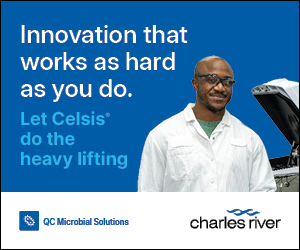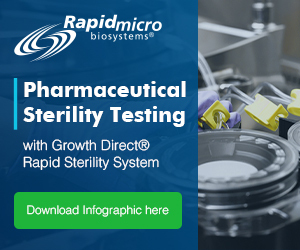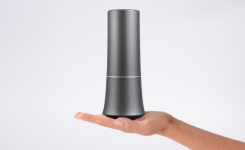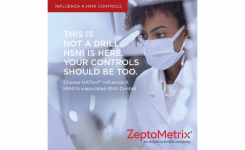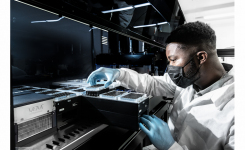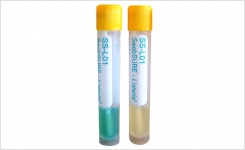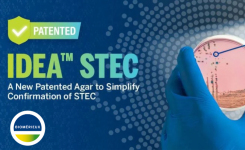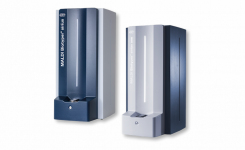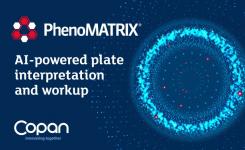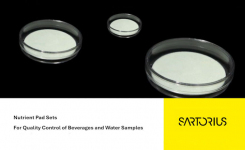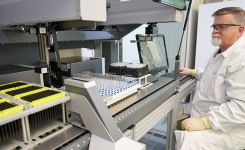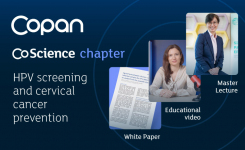Implementation of Milliflex Rapid Bioburden Test at Ortho-Clinical Diagnostics
go back to news archives| For the past ten years, the Microbiology Laboratory at Ortho-Clinical Diagnostics in Rochester, NY, had used conventional microbiological tests such as the filtration method or a direct plate method with an incubation period of 7 days before results can be reported as no growth. In 2005, the laboratory saw a 50% increase in the volume of testing. In order to meet the increased demand on the laboratory, Ortho-Clinical Diagnostics identified an automated system, which was installed and validated to automate the testing and data reporting which resulted in increased productivity attributed to cost avoidance. The Milliflex Rapid Microbiology Detection and Enumeration System was selected based on the quantitative technology of the system and rapid incubation time. Several studies have been conducted to determine if this system is appropriate for Ortho-Clinical Diagnostics application. Initial studies were conducted at another Johnson & Johnson Company where it was determined that Ortho-Clinical Diagnostics products were compatible with the Milliflex Rapid system. Further studies were conducted at Millipore and it was determined from these studies that a 16-hour incubation at 28°C was the minimum time for detection of microorganisms of interest to Ortho-Clinical Diagnostics. The equipment associated with this system was then installed and validated in the microbiology laboratory to perform product release testing. Further feasibility studies where then performed in-house to qualify the filtration method for all products as well as to determine the minimum and maximum incubation times which were determined to be 16 hours +/- 2 hours for rapid detection. Ortho-Clinical Diagnostics has demonstrated innovation through the Process Excellence process by using the Define; Measure; Analyze; Innovative/Improvement; Control Road Map (DMAIIC), to improve bioburden product release testing as described in the next section. The first step was to define and determine scope of the project, which is the Define phase. The bioburden product release test requires improvements due to the long cycle time of 7 -10 days causing a bottle- neck in the release process, which led to shipping delays, space constraints in warehouse, and unnecessary inventory and carrying costs. The scope of the project included all products released from Fluids Manufacturing that require bioburden testing. The next step was to determine the Business Benefits:
The goal of the project was to identify and validate an alternate microbiology test method. In the Measure phase the current bioburden process was reviewed. The current steps of the process consisted of receiving the samples, processing samples and paperwork, the bioburden test, and final results reported. All parts of this process were analyzed and it was determined that the bioburden test is the longest part of the process. In the Analyze phase a Fishbone diagram was used to identify potential causes of why the bioburden test was so long. It was determined from this analysis that the incubation of the test samples was the longest part of the bioburden test. In the Innovative Improvement phase a new method was selected, validated and implemented. Selecting a New Method: Several automated test methods were analyzed by using a solution prioritization matrix in order to review several different systems against criteria such as part 11 compliance, quality, quantitative vs qualitative results, length of incubation, cost of equipment, cost per test and ease of validation. These criteria were weighted for each method and the method with the highest rating was selected. This method was the Milliflex Rapid Microbiology Detection and Enumeration System. The difference between the current test method and the new test method is the following: The current test method consisted of filtering the sample, incubating for 5-7 days, manually counting the plates, and then manual documentation. The new method consisted of filtering the sample, incubating for shorter duration which was determined to be 16 hours +/- 2 hours, spraying with reagent and then detection, counting by a computer system which stores the results and a report is then printed by the user. Milliflex Rapid System Validation and Implementation: The bulk of the work was done during the pre-validation phase. This consisted of product compatibility studies on a Milliflex system at another Johnson and Johnson company. Microbial recovery studies were conducted at Millipore to determine preliminary incubation times to be used for rapid detection. Since the rapid method requires sample filtration all OCD products were transferred to the filtration method and >= 70% recovery was demonstrated between the methods as per USP <1227> Chapter for Microbial Recovery. Lastly, more studies were conducted to confirm the final testing protocol, which included the incubation time. Once pre-validation was completed, a formal validation, which consisted of Installation Qualification, Operational Qualification, and Performance Qualification was executed. Validation is the process of ensuring that products or processes can consistently meet predefined acceptance criteria. Millipore installed and ensured the Milliflex equipment worked as intended as per a pre-approved IQ/OQ protocol provided by Millipore. The PQ protocol was written by OCD following recommendations from Millipore and PDA Technical Report No. 33, May/June 2000, Vol. 54 Number 3. The recommended validation attributes to be used in validating a new test method was as follows: Accuracy, Precision, Specificity, Limit of Detection, Limit of Quantification, Linearity, Range, Ruggedness, Robustness, and Equivalence. The corresponding criteria used to validate at OCD are described below:
In the Control Phase, controls were put in place to address the failure modes identified on the Autospray Station, which is the part of the Milliflex Rapid system that dispenses the reagents required for rapid detection to occur. These controls were routine calibration and weekly spray volume checks for the Autospray Station. Once the Validation of the Rapid System has passed all the acceptance criteria and the Controls are in place, the system is ready for production. The start date of using the system must be decided by taking into account training for lab associates, production schedule, and effective SOP's. Draft Standard Operating Procedures should have been developed using Millipore's User Manuals for the Milliflex Rapid System. The testing protocol, which includes the shorter incubation time and temperature as well as the various products, must also be documented in an SOP. These draft SOPs are approved through the change control process and made effective for production use. At this time the system can be used for regular product. FDA Acceptance of Rapid Methods According to the literature there seems to be evidence that automating microbiological test methods is supported as long as it can be proven to be equivalent to a compendial test method. According to the United States Pharmacopeia (USP) 24, ' Alternate methods may be used to determine if product complies with Pharmacopeial standards for advantages in accuracy, sensitivity, precision, selectivity, adaptability to automation or computerized data reduction, or other special circumstances ' [1]. According to the PDA technical report, the 21 CFR 610.9 (Code of Federal Regulations) also recognizes that equivalent methods are acceptable [1]. Further evidence that rapid microbiology test methods are supported is through the application of Process Analytical Technology (PAT). PAT is a risk-based in-process measurement of materials and process controls through the use of rapid microbiology methods. The FDA has approved the use of a rapid method through the introduction of PAT at GlaxoSmith Kline for Microbial Limits Testing of pharmaceutical- grade water and product release of selected dosage forms (Newby, 2004 [2]). The future direction of implementing rapid methodology in the pharmaceutical industry is through the PAT initiative and through increased successful implementations throughout the industry. Due to the real-time delivery of results and as a prerequisite to PAT, rapid methods will be invaluable (Newby, 2004 [2]). In summary, Ortho-Clinical Diagnostics has demonstrated innovation by utilizing the Process Excellence DMAIIC Road Map to improve the product release process. The solution was to select a rapid technology to reduce testing cycle time and warehouse storage costs. The selected method was the Millipore Milliflex system, which is based on Adenosine Triphosphate (ATP) Bioluminescence Technology. This allows for test results to be reported faster. Ortho-Clinical Diagnostics installed and validated this system successfully and has been using the Milliflex system for releasing In-Vitro Diagnostic products for shipment to customers since January 2007. Finally, there is evidence that supports the FDA's acceptance of automating microbiological test methods in other industries as long as it can be proven to be equivalent to a compendial test method. [1] Evaluation, Validation and Implementation of New Microbiological Testing Methods. PDA Journal of Pharmaceutical Science and Technology, Technical Report No. 33, May/June 2000, Vol. 54 Number 3. [2] Newby, Paul et al, ' The Introduction of Qualitative Rapid Microbiology Methods for Drug-Product Testing ', Pharmaceutical Technology, 2004, pages 6-12. [3] Harber, M.J., (1982). ' Applications of Luminescence in Medical Microbiology and Hematology ', Clinical and Biochemical Luminescence. Kricka, L.J. and Carter, T.J.N. (eds), Marcel Dekker Inc., New York, USA, pages 189-218. [4] Millipore Product Literature (2005). 'Milliflex Rapid Microbiology Detection System '. Literature Number DS1026EN00 Rev. A 11/05, www.Millipore.com. |
NOTE: This item is from our 'historic' database and
may contain information which is not up to date.
Source : Millipore Corp View Company Information
Posted on January 12, 2009


